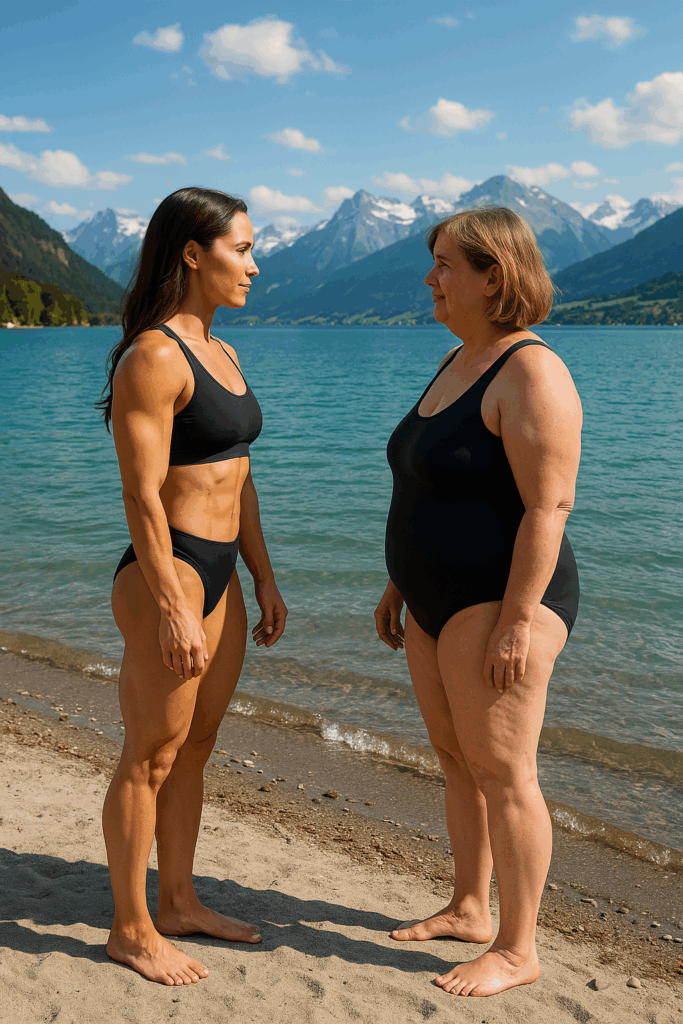Low GH and Athletes = The Perfect Storm for Injuries and Fat Gain
Executive Summary
Natural growth hormone (GH) production drops 50–70 % from the 20s to the 50s. For athletes this means slower tissue repair, longer recovery windows, declining tendon and ligament strength, rising fat mass (especially visceral), and increased soft-tissue injury risk. Testosterone falls in parallel — typically 1–2 % per year after age 30 — compounding these effects.
While recombinant human growth hormone (HGH) can add ~2 kg lean mass in short trials, it’s costly and linked to higher rates of edema, insulin resistance, and carpal tunnel syndrome. GH secretagogues such as Ipamorelin (100–300 µg 1–3×/day), CJC-1295 (1–2 mg weekly or 200–300 µg daily if no-DAC), and their combination can raise GH 2–10× and IGF-1 1.5–3× in published human data, while preserving normal feedback loops and costing far less. Tesamorelin (2 mg/day) is FDA-approved for visceral fat reduction and offers a gentler option.

These peptides aren’t magic bullets, but when paired with smart training, nutrition, and sleep, they can help older athletes bounce back faster, maintain lean mass, and reduce tendon and joint breakdown with fewer side effects than direct HGH.
Why GH Matters to Athletes

- Collagen synthesis & connective tissue — GH and IGF-1 directly stimulate fibroblasts and tendon cells. Low GH correlates with lower tendon stiffness and higher rupture risk in masters athletes.
- Muscle & body composition — GH supports satellite cell activation and fat oxidation. Decline means sarcopenia and increased trunk fat even when training volume stays high.
- Recovery & repair — Lower nightly GH pulses delay remodeling of microtears from strength or endurance work. Over time, the “recovery threshold” drops, meaning normal sessions can exceed the body’s repair capacity.
- Metabolic resilience — GH interacts with testosterone; when both fall, insulin sensitivity and lipid handling worsen, amplifying visceral fat gain.
Through the Decades: What Athletes Feel
- 20s — Peak anabolic environment
Frequent high-amplitude GH pulses plus robust testosterone drive muscle repair, tendon turnover, and lean mass. - 30s — Subtle slowdown
GH output slides ~15–20 %. Recovery after big training blocks is slower; first nagging Achilles or patellar tendinopathy may appear. - 40s — Noticeable decline
GH pulses flatten; pituitary sensitivity drops. Time off needed between hard sessions grows; soft-tissue injuries cluster. Testosterone is typically down 20–30 % vs. early 20s. - 50s+ — Steep drop-off
Athletes may have <⅓ of youthful GH and markedly lower testosterone. Lean mass drops 3–5 % per decade; visceral fat and metabolic risk rise. Recovery from HIIT or heavy lifting can take twice as long, and partial tears linger.
Overtraining & Injury Risk Rises
- Younger: High GH buffers overload but can still fail under chronic excess.
- Midlife: Lower GH + lower T = unrepaired microdamage; tendinopathies and slow-healing strains common.
- Older: High injury risk if training is not carefully periodized.
Peptide Therapy: Practical GH Support
Ipamorelin
- Selective GH secretagogue; no cortisol or prolactin spike.
- Half-life ~2 h.
- Dosing: 100–300 µg SC 1–3×/day (often AM fasted & pre-sleep).
- Benefits: GH pulses, modest IGF-1 rise, tissue repair, fat use.
CJC-1295 (DAC)
- Long-acting GHRH analog; half-life ~6–8 days.
- Single injection can raise GH 2–10× for ~6 days; IGF-1 1.5–3× for ~9–11 days.
- Dosing: 1–2 mg weekly (DAC) or 200–300 µg daily (no-DAC).
CJC-1295 + Ipamorelin
- Fast spike + sustained baseline.
- Typical: 200–300 µg of each, AM fasted & PM pre-sleep, 8–12 weeks on / 4 weeks off.
Tesamorelin
- FDA-approved 2 mg/day; strong visceral fat reduction, milder overall GH drive.
- Popular off-label for older athletes wanting midsection fat loss and joint-friendly recovery.
Peptides vs HGH: Quick Comparison
| Feature | Peptides | Recombinant HGH |
| Mechanism | Stim natural GH | Direct GH |
| Cost | Few $100s/month | $1–2k+/month |
| Side effects | Mild fluid retention, hunger | ~30 % edema/joint pain; insulin resistance |
| Feedback loops | Preserved | Suppressed |
| Body comp | Anecdotal lean gain, fat loss, faster repair | ~2 kg lean mass/20 d but no VO₂/strength gain |
| Legality | Off-label; grey | Strictly controlled/banned in sport |
Practical Takeaways for Masters & Active Adults
- Think of recovery threshold: training that felt fine at 30 can now exceed your repair capacity due to low GH/T.
- Periodize & monitor: track HRV, soreness, sleep; don’t hammer high-intensity blocks back-to-back.
- If exploring peptides: check IGF-1 and glucose, cycle 8–12 weeks on/4 off, and combine with strength and mobility work.
- Consider testosterone evaluation too — low T plus low GH is a double hit to tissue repair and lean mass.
Conclusion

You can’t stop GH decline, but you can adapt. Smart training plus modern GH secretagogues (Ipamorelin, CJC-1295, Tesamorelin) — and attention to testosterone health — give aging athletes tools to stay leaner, recover faster, and reduce injury risk. They’re not shortcuts; they’re physiology-aligned aids when used with medical oversight and proper lifestyle support.
References (AMA Style)
- Godfrey RJ, Madgwick Z, Whyte GP. The exercise-induced growth hormone response in athletes. Sports Med. 2003;33(8):599-613.
- Teichman SL, Neale A, Lawrence B, et al. Prolonged stimulation of GH and IGF-I secretion by CJC-1295. J Clin Endocrinol Metab. 2006;91(2):799-805.
- Walker RF, Riviere LJ. CJC-1295 and age-related GH decline. J Clin Pharm Ther. 2012;37(4):471-477.
- Svensson J, Lindeberg A, Långström B. Ipamorelin: a selective GH secretagogue. Clin Endocrinol (Oxf). 2000;52(1):21-29.
- Tsujimoto G, Ohashi H. Effects of ipamorelin on muscle recovery. Horm Res. 1995;43(5):218-223.
- Bhasin S, Storer TW. Tesamorelin: muscle and tissue repair. J Clin Endocrinol Metab. 2009;94(5):1752-1760.
- Blackman MR, Sorkin JD. GH releasing peptides and aging muscle. Ageing Res Rev. 2002;1(1):41-58.
- Feldman HA, Longcope C. Age trends in testosterone. J Clin Endocrinol Metab. 2002;87(2):589-598.
- Mayo Clinic. Growth hormone: Does it slow aging? Healthy Aging. Accessed 2025.
- Harvard Health Publishing. Growth hormone, athletic performance, and aging. Accessed 2025.